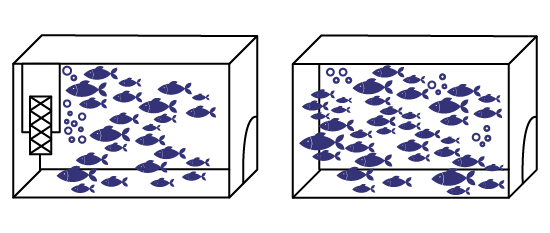B1.3 Estimate the number of objects in collections of up to 200 and verify their estimates by counting.
Activity 1: Aquariums (Estimating)
Directions
Present the following situation to the students.
The mayor of your city wants to install two large aquariums in the entrance of the city hall. However, there are two conditions: he wants no more than 60 fish per aquarium and no more than 200 fish in total. The city council members make proposals.
Project the first proposal and ask students to estimate the number of fish in each aquarium and the total number of fish.
First proposal

Use the ten frames to check estimations by comparing the number of fish in one-to-one correspondence.
Ask students if the mayor should accept this proposal and then explain their reasoning.
Project other propositions and ask students to check them by first estimating the quantities and then checking the propositions.
Ask students to make their own suggestions and check them.
Teacher Moves
Discuss the estimations and proposals with students by asking questions that have them reflect on the reasonableness of their estimations and proposals:
- How likely is your estimation? How do you know?
- How do you know that this proposal is acceptable?
- Does it take into account both of the mayor's conditions?
Source: translated from Guide d’enseignement efficace des mathématiques de la 1re à la 3e année, Numération et sens du nombre, p. 55.
Activity 2: Fill It Up!
Materials
- appendix 3Q.3 (Fill It Up!)
- appendix 3Q.4 (The Great Cover-Up) (one copy per student)
Project Appendix 3Q.3 and place a square-shaped pattern block on the figure shown.
Ask a few students to estimate the number of pattern blocks needed to completely cover the figure. Write their estimation on the interactive whiteboard.
Invite the students, in turn, to come and place a square-shaped pattern block on the figure.
Pause when a few pattern blocks have been added and ask students if they would like to change their estimation.
Ask students to explain why more accurate estimations can be made when more information is available.
Provide each student with a copy of Appendix 3Q.4.
Ask students to choose a pattern block and estimate the number of them that will be needed to completely cover the shape.
Discuss with students strategies for making estimations and the usefulness of benchmarks.
Remind students that this is an estimation activity and that they might not be able to cover the surface of the figure exactly.
Ask students to check their estimations using the pattern blocks, to reflect on how accurate it was, and how they might adjust their strategy.
Project the figure, if necessary.
Ask students to estimate the number of pattern blocks needed to cover a larger area (for example, a sheet of paper or the top of a desk).
Encourage students to use a benchmark as a strategy for making an estimation.
Source: translated from Guide d’enseignement efficace des mathématiques de la 1re à la 3e année, Numération et sens du nombre, p. 198.
Activity 3: The Gumball Machine
Project a gumball machine and cover it with circle gumball stickers or show students a real machine filled with gumballs.
Ask students to estimate the number of gum balls in the dispenser.
Encourage students to use a benchmark by showing them sets of 5 or 10 stickers (or gumballs).
Use large stickers the first time and then smaller and smaller stickers as students are able to make better estimations.
Discuss with students how to adjust their estimations based on the size of the stickers.
Source: translated from Guide d’enseignement efficace des mathématiques de la 1re à la 3e année, Numération et sens du nombre, p. 199.
